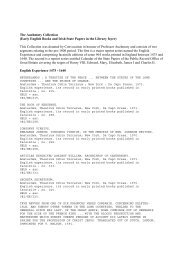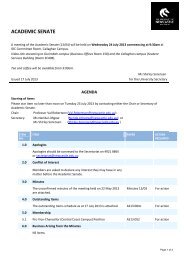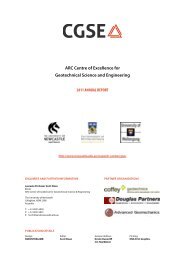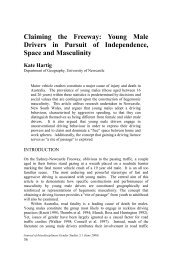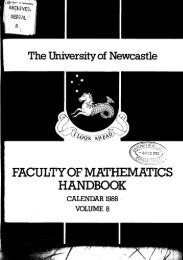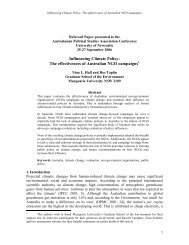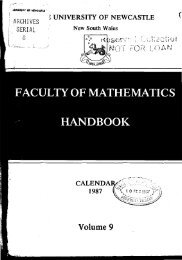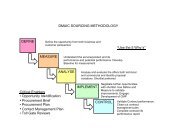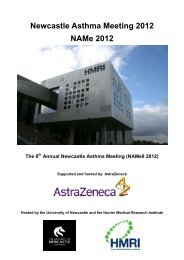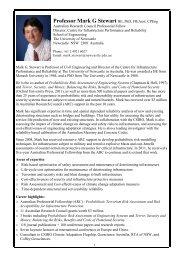n - University of Newcastle
n - University of Newcastle
n - University of Newcastle
Create successful ePaper yourself
Turn your PDF publications into a flip-book with our unique Google optimized e-Paper software.
I have no cloubt that this is the same Dravidian termination<br />
-illi which me shall find in ta-killi-k o ancl in many other Awabakal<br />
morcls, but here aclded on to the same root which we find in<br />
the Sanskrit cli(p), 'to shine.'<br />
The Ebudan <strong>of</strong> Eaki has sembi to mean 'fire'; now se~nbu<br />
in Draviclian means '~-ecl.' In Australia, a very general word for<br />
'fire' is n~i, will ; in the north-west <strong>of</strong> Tasmania it is win-alia ;<br />
these I take to be from the same root as our mil, ' the eye,' and<br />
the Dra~iclian m in. In Tasmania also, tint y a means ' recl';<br />
to which cognates are the Sanskrit clamh, clah, ' to burn,' dams,<br />
clam$, ' to bite,' ' to see'; in Tamil tincl-u, is ' to kindle,' tittu,<br />
' to whet'; cJ: Anglo-Saxon tendan, 'to kinclle,' English tinder.<br />
Besides mata, the Maoris have another word for 'eye,' kano hi,<br />
which much resembles the Dra~idian kan, ' the rye,' k&n, ' to<br />
see '; and the root <strong>of</strong> kan may be the same syllable as in Sanskrit<br />
ak-shi, 'eye,' the ak being by metathesis changed into ka. At<br />
all events, the root kan is abundantly preralent in the sporaclic<br />
languages ; for the Maori itself has kana, 'to stare milcUy,' that<br />
is, 'to look keenly '; ka, 'to burn '; ka-ka, 'red-hot '; kana-pa,<br />
' bright,' ' shining '; kana-kn, ' fire '; ancl cognate Polynesian<br />
clialects have kano-i-mata, 'the pupil (i.e., ' the sheen ') <strong>of</strong> the<br />
eye '; 'a 'ano, certain ' red berries,' ' the flesh <strong>of</strong> animals,' from its<br />
recluess ; ka-napa-napa, ' to glitter '; ka-napa, 'lightning.' The<br />
simple root Ira gives la, ra, 'the sun,' and all the Polynesian<br />
words connected with these forms.<br />
Nor is this 'oot-word ka, kan confined to Polynesian dialects ;<br />
in Ebuclan, ' fire ' is in-cap, liapi, kapu, gapu, av, ay i ; and<br />
the Papuan clialects have for 'fire,' kova, kai-ma ; for burn,'<br />
ogabu, igabi. And kai-o in Greek is ' I burn.'<br />
It is interesting to know, also, that in the st&tes vliich form<br />
the Himalayan boundary <strong>of</strong> India the morcls for 'eye' are mi,<br />
mik, mighi, malr, mo, mak, mo; and, farther east, in Cochin-<br />
China and Tonkin, mot, mok, mu. It thus appears that, on the<br />
whole our comrnonword mil, 'the eye,' is more akin to the non-<br />
Ai-yan races <strong>of</strong> India-the representative~ <strong>of</strong> its earlier - pol~ulation. -<br />
In closing this section <strong>of</strong> my subject, I presume I need scarcely<br />
say that the evidence before us drawn from the words for 'rrater,'<br />
'blincl,' and 'eye,' fully justifies the opinion that the Australian<br />
la~lguages are not isolated, but that, in their essential root-words,<br />
they have a close relation to the languages <strong>of</strong> the Southein Seas<br />
and to similar root-words in the languages <strong>of</strong> the great peninsula <strong>of</strong><br />
India. I cannot conceive it to be possible that our blackfellows<br />
should have, by chance, inventecl words mluch, when analysed,<br />
show the underlying idem expressed by them to be the same as<br />
those root-mords spread orerso 1-ast an area elsewhere.<br />
INTBODUCTIOH.<br />
YII. MI~CELLANEOUS TEST 'WOEDS.<br />
(n.) There are just two or three other rords which I mould<br />
glance at very rapidly. The Malay kutu means ' louse '; in all<br />
Polynesia also that word means ' louse '; therefore, as some<br />
persons say, the South Sea Islanders must be Malay-Polynesians.<br />
But I find that in Aneityum also, a Papuan region, in-ket is<br />
'louse,' and in South Australia IiGta, and in other parts <strong>of</strong><br />
Australia, k ti-lo, gullun. To complete the analogy, these persons<br />
should now say that the Papuans <strong>of</strong> the New Hebrides and<br />
the blacks <strong>of</strong> South Australia are Malay. This looks like a<br />
~eductio ad nbsurrlzcnz.<br />
(b.) The word Irn t u reminds lEe that there are some very unsavoury<br />
words, which are a strong pro<strong>of</strong> <strong>of</strong> identity <strong>of</strong> ongin<br />
among races ; for, if these words have not come from one common<br />
source, it is scarcely possible to imagine how they are so much<br />
alike. For instance, gc-nung here means ste~clss houzinis nut<br />
Zesfiae; in Sanskrit the root-verb is gu. In Samoan, (k)i-no is<br />
' excrement,' the same mord as git-nung. Among our Port<br />
Stephens blacks, the worst <strong>of</strong> the evil spirits is called giinungdhakia='sfercus<br />
edens.' .In Hebrew, a variant for the name<br />
Beelzebub is Beelzebiil, which means dominzts sfereoris.<br />
Again, kak is an Aryan root-veh ; in Kew Guinea it becomes<br />
tage (t fbr k, as is common) ; in New Britain, talc ; in Samoa,<br />
t n'e ; in Aneityum, no-holr and na-he h. The Sanskrit bhaga,<br />
which I need not translate, is in Fiji mnga; aild in Tasmania,<br />
maga; ard pi, mi, as I have alrezdy sho~vn, is as old as the<br />
' is puggrtnubrana or<br />
the vocabularies <strong>of</strong> that<br />
e meaning <strong>of</strong> pugga. I<br />
ith the New Britain word<br />
' day '; thus biiganubra<br />
s, 'the sun '; and that is<br />
Malay mord for the ' sun.'<br />
arid the Fijian for ' sun'<br />
the Dravidian pa g-al,



